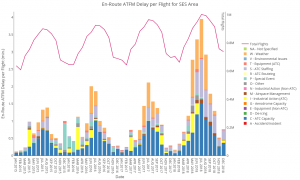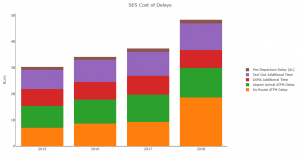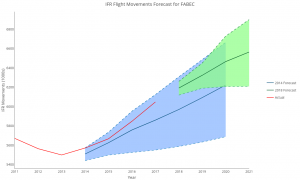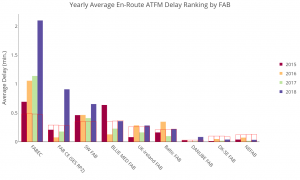Since the beginning of Reference Period 2 of the Single European Sky (SES) Performance and Charging Scheme in 2015, European airspace has been adversely affected by substantial delays, both in terms of en-route and airport arrival ATFM delay, as well as ATC associated delays for airport departures. However, the en-route ATFM delays have been especially severe during the summer of 2018, where the maximum monthly delays per flight are almost double the previous years (Figure 1).

Figure 1: SES En-route ATFM Delay 2015 – 2018
When en-route ATFM delay is combined with other sources of delay from airport ATFM, arrival sequencing delay (measured by ASMA additional time), departure runway queuing delay (measured by taxi-out additional time) and departures waiting at stands to relieve runway congestion (ATC pre-departure delay) – it results in an estimated cost exceeding €4bn (Figure 2) for airlines operating out of the area.

Figure 2: Annual Cost of Delays in the SES Area (Eurocontrol)
Traffic growth has been surpassing forecasts year on year in many FABs putting increasing strain on airport ATC capacity, which has been further exacerbated by shortages in air traffic controllers. The airspace most impacted by delays in 2018 was FABEC, and in particular in France and Germany, with en-route ATFM delays surpassing the FAB delay target by over 400%; Indeed, forecasted IFR movements before RP2 in 2014 had greatly underestimated actual traffic growth in the region (Figure 3).

Figure 3: Forecasted IFR Traffic Growth vs Actual Traffic Growth FABEC
As Figure 4 demonstrates, the same level of delay is not evident across the whole of SES – but as growth continues the high delays are forecast to spread if urgent action is not taken.

Figure 4: Average Annual En-Route ATFM Delay By Functional Airspace Block (FAB)
Without greater support and cooperation between SES, the member states and ANSPs, this recent trend of delays will very likely continue, with consequences for the European economy and aviation industry. More needs to be done to facilitate greater cooperation between ANSPs and to strengthen SES governance to increasing focus on accelerating the deployment of new capacity enhancing systems. Member states and ANSPs should also work together to ensure that detailed plans are in place for medium- and long-term capacity enhancements, providing greater resilience to long term traffic growth trends. Reliable air travel is vital for the movement of people, goods and ideas throughout Europe, investing in airspace systems and infrastructure today will no doubt bring with it benefits and economic growth for years to come.

Author: Derry Leng, ATM Consultant
N.B: Please note that data used in the charts above has been published by the EUROCONTROL Performance Review Unit. Click here to find details of their Copyright notice and disclaimer.


Recent Comments